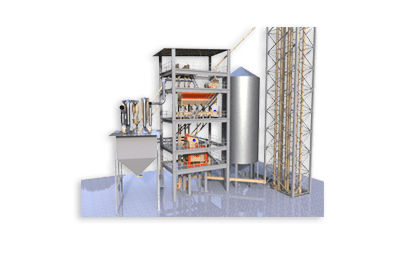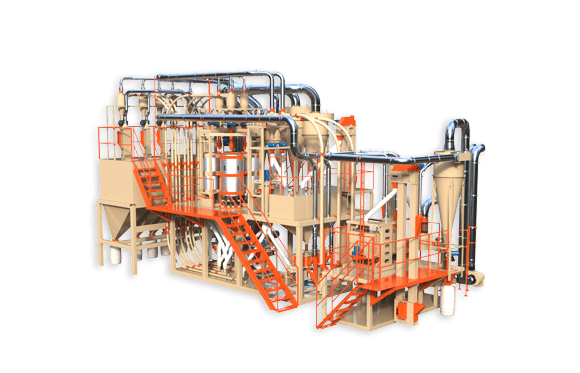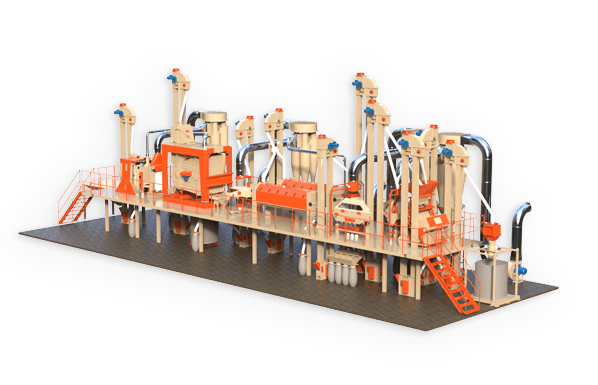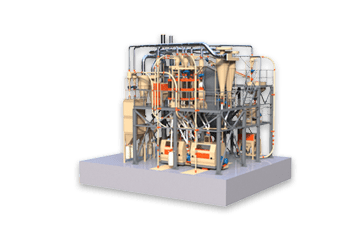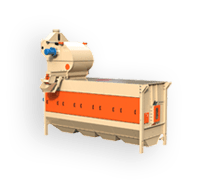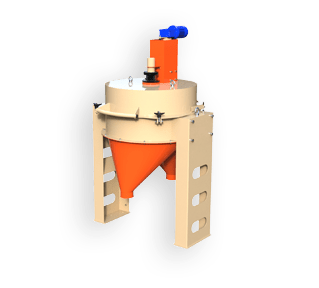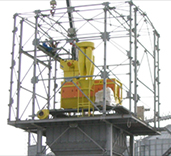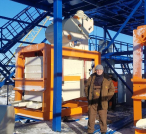Science and practice of improving the efficiency ofvariety bakery grinding of wheat
The technical re-equipment of the domestic flour milling industry, which was carried out in the 80-90s of the last century, made it possible to significantly increase the efficiency of flour production and potential processing opportunities due to the introduction of advanced, at that time, technologies. Their basis was the implementation of the scientifically based and practically tested principle of selective grinding due to the development of enrichment processes and differentiated action on the product. Flour mills with a capacity of 500 and 250 t/day of the “Buhler” firm were distinguished by the maximum degree of grain utilization, high product quality and formed the basis of the flour milling industry of the Soviet Union. However, the reformation of the domestic economy carried out in subsequent periods had a significant impact on their work and the transformation of the flour industry. It turned out that in the new economic conditions, technologies created according to developed structures are too energy-intensive, require a large number of various machines, significant production areas and other resources. In addition, the shortcomings characteristic of high-productivity industries were revealed: significant costs of material, labor, and energy resources for the centralization of raw materials, the distribution and sale of finished products, the high inertia of production processes, and the difficulty of prompt response to sudden changes in market demand. The flour milling industry needed productions of smaller, local productivity, with lower costs for creation and operation.Flour mills built on the basis of shortened and short structures of the processing process have been and are being implemented rapidly in the country. Although such productions produce about 30% of wheat flour, they only partially meet the requirements for its quality and yield. The low level of grain utilization and the low quality of the produced flour are in most cases an insurmountable problem of these productions.
Thus, today the flour milling industry of Ukraine is represented by typical flour milling plants with a capacity of 500 and 250 t/day, built more than 30 years ago, which have survived to this day without significant changes, implementing developed milling structures, as well as various new productions of lower productivity, as imported , as well as of domestic construction, which realize reduced and short structures of mills.
The disadvantages inherent in the listed productions, in our opinion, are to a large extent due to the fact that with the appearance of flour mills of the Büller firm, significant forces of official domestic science, instead of critical analysis and development of these and other technologies, were engaged in the interpretation, justification and conservation of Büller technologies as something final and not surpassed Many promising, as time shows, research and development were not brought to wide implementation in production. Until recently, no one in the industry wanted to change anything, and even more so to engage in thorough preparation in advance for the inevitable next re-equipment of the flour milling industry. The transition to a market economy exacerbated the need to find and develop methods of increasing the competitiveness of flour mills, and also opened the way to their implementation, since the tasks of improving production began to be taken care of directly by their owners, managers and specialists, and not by ministries and administrations.
It is the development and introduction into production of new grain processing technologies and the means of their implementation that is the direction of the work of the “OLIS” company, and my personal activity as its manager and specialist. Within the scope of the report, it is impossible to describe everything that we have worked on in the direction of improving wheat wheat flour varieties, so I will dwell only on the main points.
As our research shows, the huge potential for increasing the efficiency of varietal bakery grinding of wheat lies in increasing the efficiency of grain preparation for grinding.Thus, according to the current “Rules for the Organization and Management of the Technological Process at Flour Milling Enterprises”, grain entering flour mills must contain no more than 2.0% of waste impurities, and in the presence of grain processing equipment at the elevator – no more than 1. 0% and no more than 5.0% grain admixture. At the same time, the maximum permissible content of waste admixture in the grain, which is sent to the 1st shredding system during bakery grinding of wheat, should not exceed 0.4%, and that of grain should not be additionally specified. However, the practice of milling shows that increasing the quality and yield of flour, especially of high grades, requires more significant removal of impurities.
Further studies of VNIIZ established that when the content of waste admixture increases by 0.1% in the grain before the first threshing system, the total yield of flour decreases by approximately 1.4% or the weighted average ash content of flour increases by approximately 0.04%. An increase in the content of grain admixtures in the cleaned grain by 1.0% leads to a decrease in the total yield of flour by approximately 0.8% or an increase in the weighted average ash content by 0.15%.
It is obvious that the standards for the content of impurities in the grain, which is sent to the preparation department of the flour mill and further to grinding, are adopted taking into account the possibility of modern cleaning technology. From the analysis of the quality standards of the grain entering the preparatory department of the flour mill and the first system of the grinding department, it follows that the actual efficiency of grain cleaning in the preparatory department of the flour mill is about 60%. This means that despite the wide arsenal of grain cleaning operations and the means that implement them, modern cleaning methods, using complex and expensive machines, as well as significant resources, are not able to ensure high technological efficiency.
Wheat grain on its surface contains a significant amount of microorganisms and dust of mineral and organic origin. In order to prevent the listed inclusions from entering the flour, as well as fruit shells and bangs, the surface of the grain is treated in the process of preparation for grinding. Such processing is traditionally carried out in upholstery machines, where the main operating factor is impact.According to the existing data of production tests, when processing grain before its hydration, the amount of separated outer covers of grain was about 0.1% with an ash content of 4.0 to 5.0%, and the amount of broken grains increased to 1.0%. During the processing carried out after the main stage of dehumidification, the amount of separated outer grain covers was from 0.01 to 0.08%, and the content of broken grains increased to 0.5%. Thus, even with double processing, on average, no more than 3…6% of the fruit shell is separated from its total content, which indicates uneven and incomplete processing of the grain. At the same time, the established norms allow obtaining up to 2% of crushed grains at each stage of such processing, that is, an increase in the content of grain impurity, which, according to the current discounts for double processing, can lead to a decrease in flour yield by more than 0.5%.
Thus, the main disadvantages of traditional grain surface treatment are low cleaning efficiency and uneven surface treatment of individual grains that are in a disconnected state, as a result of which they are subjected to dynamic loads of different nature and magnitude, which lead to the destruction of a significant number of grains.
Compared to hot methods of hydrothermal treatment, the cold method does not require expensive and complex equipment using steam, vacuum or excessive pressure, as well as energy costs due to the need to heat the grain to a temperature of 50…70˚С. The specified advantages determined the use of exclusively cold air conditioning in modern economic conditions. However, the implementation of the cold WTO method is complicated by the limited water-absorbing capacity of the grain during moistening, which in some cases requires this operation to be carried out in several stages with intermediate moistening. In addition, to ensure the technological effect during cold conditioning, long-term grain dehumidification is required, which requires the presence of large-capacity bunkers. Thus, in accordance with the current recommendations, depending on the vitreousness and initial moisture content of the wheat, the increase in moisture during one stage of moistening does not exceed 3.5%, and the total recommended duration of moistening may exceed 24 hours. Due to this, the capacity of the dehumidification bunkers is 1.5 times higher than the daily productivity of grain processing at flour mills that implement grinding according to typical structures.It has long been known that a whole grain is a natural structure that has a fairly strong ellipsoidal frame, reinforced by the strongest anatomical part of the grain – the shell. When creating external forces, the frame behaves as a monolithic structure. It is also known that the resistance to destruction of the whole grain as a complex structure is higher than that of the endosperm and somewhat lower than the strength of the shells. Thus, when grinding grain, it is necessary to apply efforts higher than that required for grinding the endosperm, which leads to an increase in energy consumption, a decrease in the efficiency of grain formation and the emergence of a threat of the formation of small particles of shells. In addition, grinding the grain together with the husks contradicts one of the main principles of varietal grinding of wheat, which was formulated in the post-war years – the principle of the sequence of release of the endosperm from the husks.
As it turns out, the listed and other disadvantages of the traditional preparation of grain for grinding can be eliminated by using the husking technology.
Our studies have shown that the efficiency of grain cleaning from impurities during the peeling process is proportional to the value of its peeling index k. Grain processing with values of the k index greater than 3.5% in terms of the efficiency of removal of waste admixture and with values of more than 4.5% in terms of the allocation of grain admixture exceeds the maximum possible efficiency of cleaning by the air-sieve method, in particular, due to the allocation of difficult-to-separate impurities.
Cleaning the grain surface by peeling significantly exceeds the efficiency of processing in upholstery machines, since peeling involves the removal of unwanted inclusions on the surface of the grain along with the entire mass of separated shells, which can reach up to 8% of the grain mass.
Humidification of dehusked wheat grain increases its moisture content by more than 3.0% compared to unhusked wheat. The rate of moisture diffusion into the endosperm of hulled grain is several times higher than that of unhulled grain. Thus, most batches of domestic wheat can be conditioned in one step while reducing the duration of dehumidification by up to 25%. At the same time, the processing of wheat grain with a husking index higher than 3…4% leads to a sharp decrease in the viability of the grain and the active development of mold fungi on the surface of its grains in conditions of high humidity. Thus, grain dehulling before conditioning is limited by the indicated values of the dehulling index.
When grinding husked grain, the quality of intermediate products is significantly improved and the output of coarse grain increases.The energy intensity of primary grinding of hulled grain is on average 30…50% lower than that of unhulled grain. Thus, the entire process of grain formation can be effectively implemented on two or even one broken system.
Flour produced from dehulled grain is characterized by improved values of the whiteness index and baking properties. In addition, during the production of flour from dehusked grain, it has been established that the aleurone layer is added to its composition, which is beneficial due to the increased content of protein and minerals in the aleurone layer.
As a result of our research, we have developed and substantiated shortened structures for the stage of grain preparation for grinding using husking, which include 10 operations, and this is 7 operations less than provided for in typical structures.
Taking into account the proposed grain preparation, methods were developed to improve the structure of the grain grinding stage, which include:
– the use of low grinding modes of husked grain, which allows to reduce the number of systems and the length of the rolling line of the shredding process while increasing the number and quality of intermediate products (especially large ones);
– exclusion of the enrichment of small grains and dunts, which is ensured by the increased quality of the specified products as a result of low modes of grain formation during grinding of husked grain;
– increasing the yield of flour when grinding intermediate products with the help of disintegrator-type machines, which allows to reduce the number of systems and the length of the rolling line of the grinding process.
For the implementation of new and improved technological operations, the MAO peeling-peeling machine, the peeling-grinding machine of the “Cascade” design and the ESM-1.5 dismembrator were created.
For the purpose of practical implementation, a technological diagram of the grain preparation stage for grinding was developed, as well as technological diagrams of the grinding stage without enrichment and with sieve-air enrichment of universal typical technological modules, as a basis for the synthesis of technological schemes of flour mills of different productivity .
Technological schemes of flour mills of various productivity, implemented using standard modules and new technological equipment, were developed and tested in production conditions.Also, structures were created, regimes were determined and technological schemes of flour mills with complete equipment were developed for their reconstruction in order to solve the most pressing tasks in the industry.
The results of laboratory and industrial research, as well as the experience of more than 20 flour mills with a capacity of 30 to 330 t/day show that the use of the technologies offered by us guarantees the production of wheat flour, which in terms of quality meets the requirements of current regulations documents, and also allows to obtain a significant economic effect during the creation or reconstruction of production and its subsequent operation.
The introduction of technology developed without the use of enrichment allows to increase the yield of high-grade flour, on average, by 10…20%, while increasing the total yield by 1…2% at flour mills of low productivity. The flour milling plant with a productivity of 60 t/day is the most appropriate in terms of technical and economic indicators. In comparison with traditional productions of small capacity, the creation of 1 ton of daily productivity of such a flour mill requires 1.7 times less equipment weight and 1.65 times the cost of its purchase. In addition, the processing of 1 ton of grain requires 8% less installed power of the equipment and more than 2 times less air.
Flour mills of medium and high productivity, which are created according to developed technologies using sieve-air enrichment, are characterized by an increase in the yield of high-grade flour by 10…15%. In comparison with flour mills, which are created according to traditional technology, to create 1 ton of daily productivity of the proposed productions, an average of 1.3 times less equipment weight and funds for its purchase are required. In addition, processing 1 ton of grain at such flour mills requires 5% less installed capacity of the equipment and 1.4 times less air.
When carrying out reconstructions of flour mills with complete equipment, the proposed reconstruction options provide for an increase in the yield of high-grade flour by 5…15%, a reduction in material consumption and the cost of the equipment used by up to 25%.
The annual economic effect of improving the quantitative and qualitative indicators of work at flour mills is:
– 30 t/day productivity – UAH 274,000;
– with a productivity of 60 t/day – UAH 1,775,000;
– with a productivity of 120 t/day – UAH 2,653,000;
– with a productivity of 240 t/day, as well as reconstructed plants with complete equipment with a productivity of 250 t/day – UAH 3,442,000.


